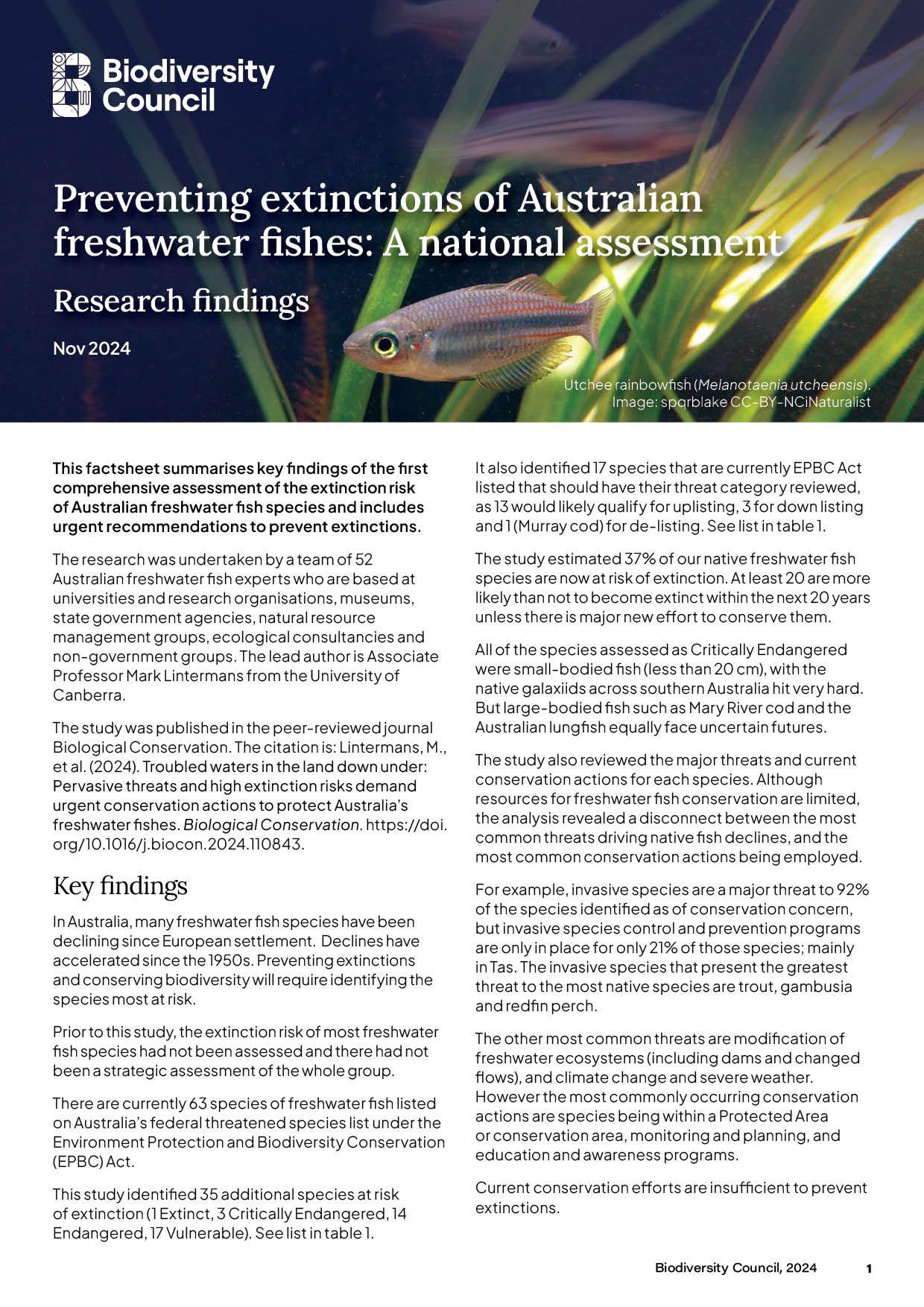
The NT’s Angalarri grunter is being badly impacted by changing water flows and temperatures and fires due to climate change. It warrants assessment for inclusion on Australia’s threatened species list. This study assessed the species as Endangered using globally recognised IUCN Red list criteria. Image: Michael Hammer.
Preventing extinctions of Australian freshwater fishes: A national assessment
Factsheet
12 November 2024

This factsheet summarises key findings of the first comprehensive assessment of the extinction risk of Australian freshwater fish species and includes urgent recommendations to prevent extinctions.
The research was undertaken by a team of 52 Australian freshwater fish experts who are based at universities and research organisations, museums, state government agencies, natural resource management groups, ecological consultancies and non-government groups. The lead author is Associate Professor Mark Lintermans from the University of Canberra.
The study was published in the peer-reviewed journal Biological Conservation. The citation is: Lintermans, M., et al. (2024). Troubled waters in the land down under: Pervasive threats and high extinction risks demand urgent conservation actions to protect Australia’s freshwater fishes. Biological Conservation. https://doi.org/10.1016/j.biocon.2024.110843
Key Findings
In Australia, many freshwater fish species have been declining since European settlement. Declines have accelerated since the 1950s. Preventing extinctions and conserving biodiversity will require identifying the species most at risk.
Prior to this study, the extinction risk of most freshwater fish species had not been assessed and there had not been a strategic assessment of the whole group.
There are currently 63 species of freshwater fish listed on Australia’s federal threatened species list under the Environment Protection and Biodiversity Conservation (EPBC) Act.
This study identified 35 additional species at risk of extinction (1 Extinct, 3 Critically Endangered, 14 Endangered, 17 Vulnerable). See factsheet for list.
It also identified 17 species that are currently EPBC Act listed that should have their threat category reviewed, as 13 would likely qualify for uplisting, 3 for down listing and 1 (Murray cod) for de-listing. See factsheet for list.
The study estimated 37% of our native freshwater fish species are now at risk of extinction. At least 20 are more likely than not to become extinct within the next 20 years unless there is major new effort to conserve them.
All of the species assessed as Critically Endangered were small-bodied fish (less than 20 cm), with the native galaxiids across southern Australia hit very hard. But large-bodied fish such as Mary River cod and the Australian lungfish equally face uncertain futures.
The study also reviewed the major threats and current conservation actions for each species. Although resources for freshwater fish conservation are limited, the analysis revealed a disconnect between the most common threats driving native fish declines, and the most common conservation actions being employed.
For example, invasive species are a major threat to 92% of the species identified as of conservation concern, but invasive species control and prevention programs are only in place for only 21% of those species; mainly in Tas. The invasive species that present the greatest threat to the most native species are trout, gambusia and redfin perch.
The other most common threats are modification of freshwater ecosystems (including dams and changed flows), and climate change and severe weather. However, the most commonly occurring conservation actions are species being within a Protected Area or conservation area, monitoring and planning, and education and awareness programs.
Current conservation efforts are insufficient to prevent extinctions.
Recommendations
Urgently assess 35 species for listing as threatened under the EPBC Act and re-assess 17 species for up-/down-/de-listing (listed in factsheet table 1).
Assess the conservation status of 15 newly described species.
Urgently develop and resource major new conservation measures that target the key threats driving declines to avoid imminent extinctions:
- Tackle the impact of invasive species on threatened native fish populations. Include major new action to address trout, gambusia and redfin perch.
- Improve flow regimes and water provision to mitigate impacts from water extraction and regulation and climate change.
- Halt ongoing habitat loss and improve habitats that have been impacted.
- Identify, establish and protect additional refuge sites for species which currently occur in only a small number of small locations which could be wiped out by a single event such as a bushfire.
See factsheet for more details.













